International Marketing Report: Trends in Australian Wine Tourism
VerifiedAdded on 2020/02/24
|8
|1464
|115
Report
AI Summary
This report examines the international marketing strategies employed by the Australian wine industry, focusing on its efforts to boost wine exports and attract international tourists. The report highlights the industry's plans to leverage social media platforms like WeChat and Weibo as part of a $50 million marketing initiative. It analyzes the trends and issues in wine tourism, emphasizing the growth and importance of this sector. The report explores the implications for international marketers, discussing the increasing popularity of wine tourism and the role of local authorities in promoting it. It also addresses the need for improved cooperation among stakeholders, aggressive marketing strategies, and enhanced employee education to maximize the benefits of wine tourism. The conclusion emphasizes the need for improved collaboration within the tourism sector and the adoption of more aggressive marketing strategies to capture the global market.
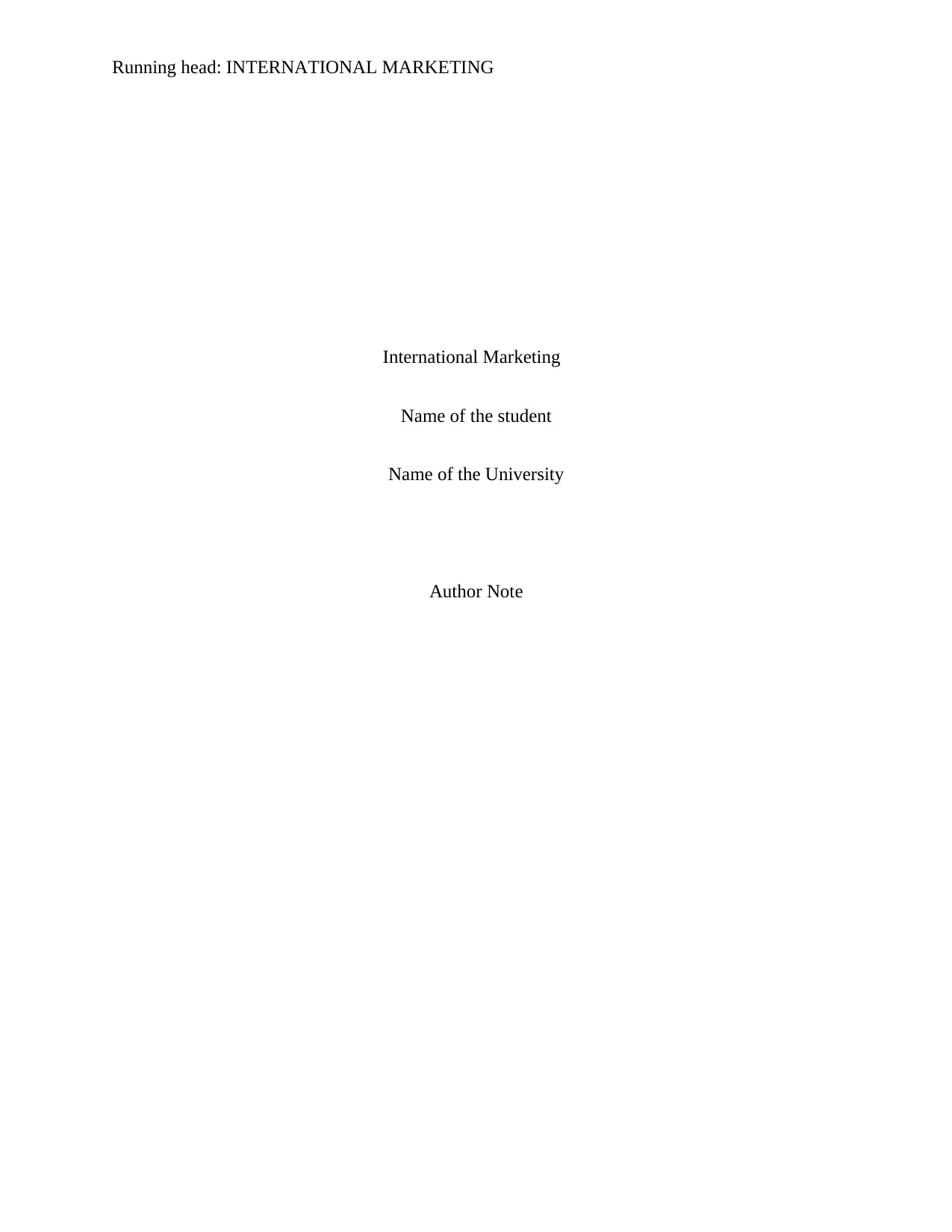
Running head: INTERNATIONAL MARKETING
International Marketing
Name of the student
Name of the University
Author Note
International Marketing
Name of the student
Name of the University
Author Note
Paraphrase This Document
Need a fresh take? Get an instant paraphrase of this document with our AI Paraphraser
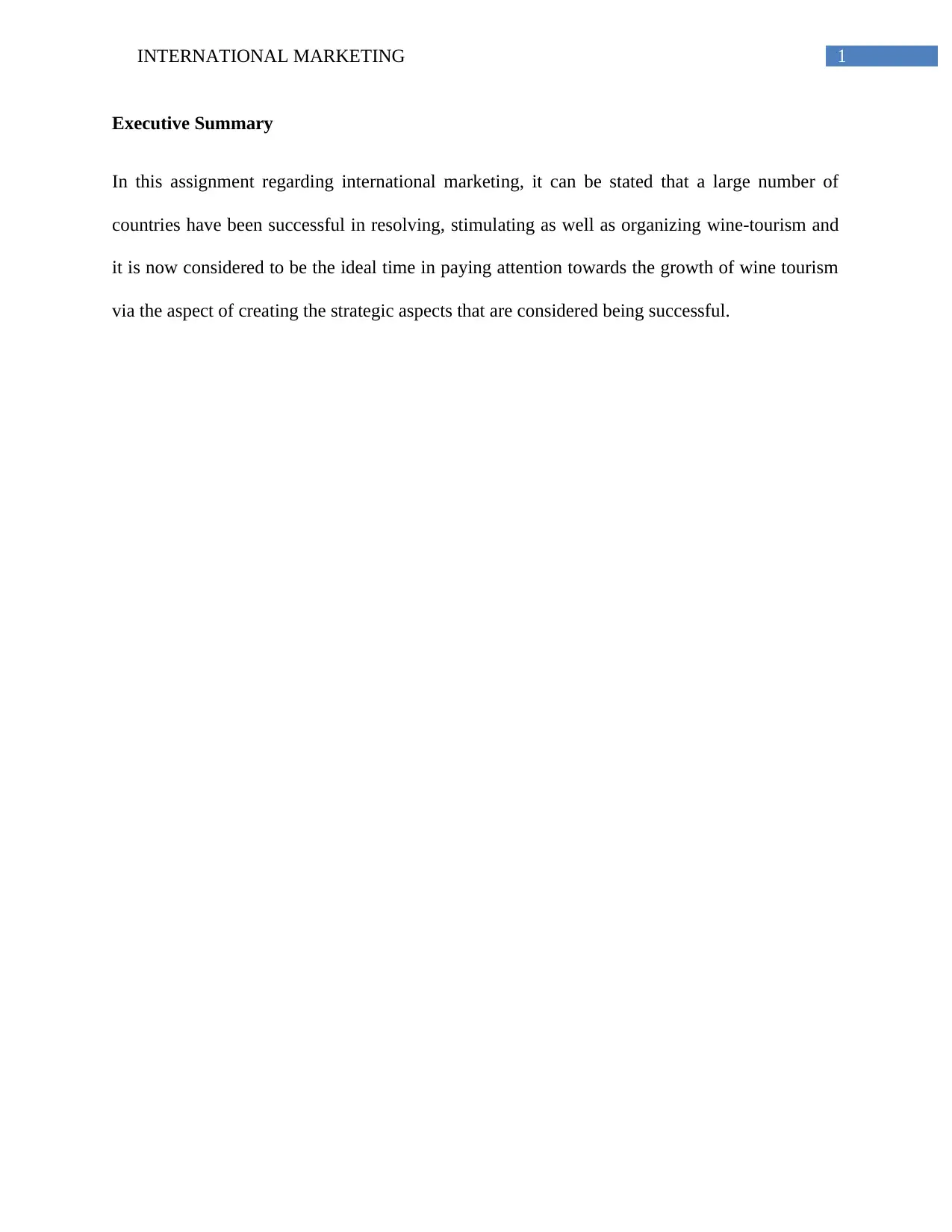
1INTERNATIONAL MARKETING
Executive Summary
In this assignment regarding international marketing, it can be stated that a large number of
countries have been successful in resolving, stimulating as well as organizing wine-tourism and
it is now considered to be the ideal time in paying attention towards the growth of wine tourism
via the aspect of creating the strategic aspects that are considered being successful.
Executive Summary
In this assignment regarding international marketing, it can be stated that a large number of
countries have been successful in resolving, stimulating as well as organizing wine-tourism and
it is now considered to be the ideal time in paying attention towards the growth of wine tourism
via the aspect of creating the strategic aspects that are considered being successful.
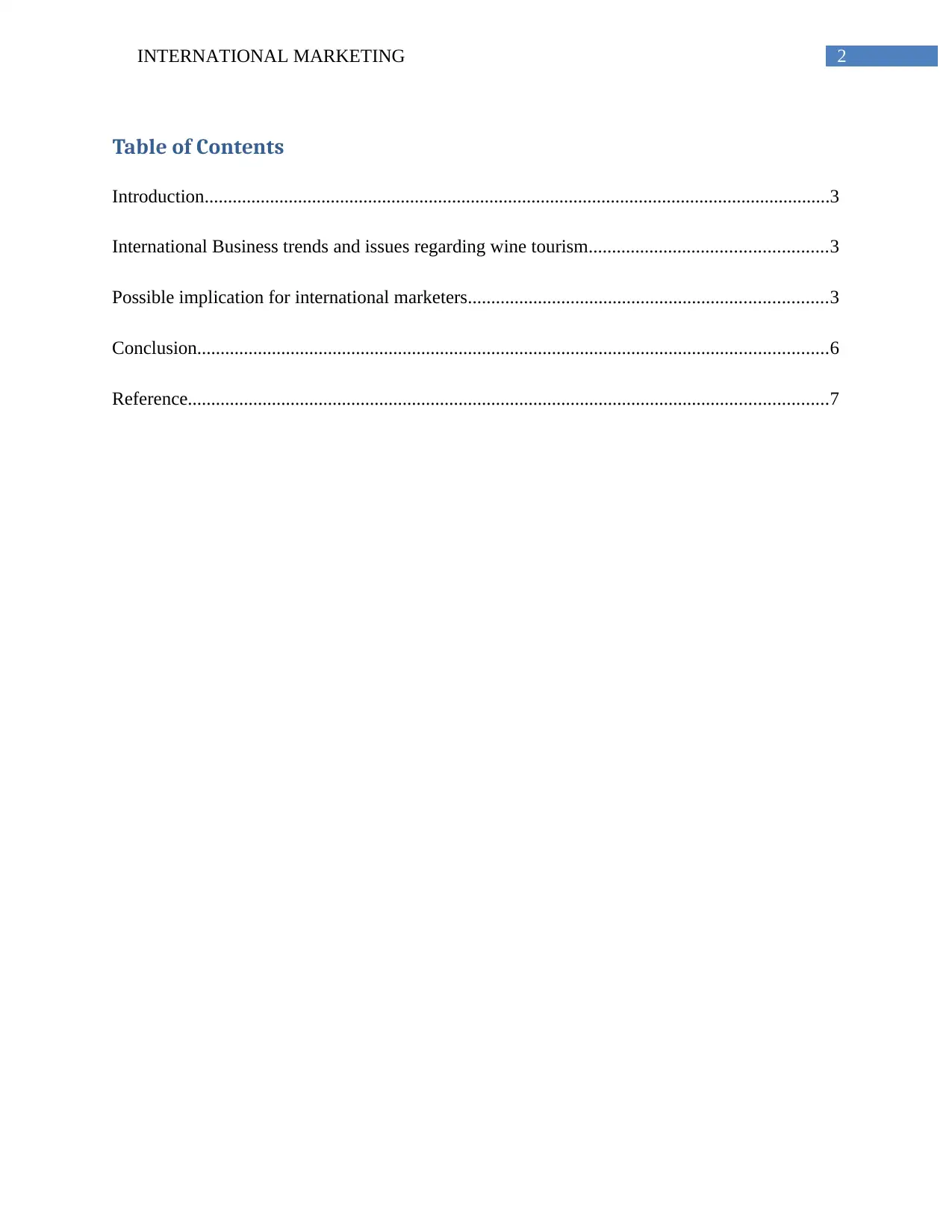
2INTERNATIONAL MARKETING
Table of Contents
Introduction......................................................................................................................................3
International Business trends and issues regarding wine tourism...................................................3
Possible implication for international marketers.............................................................................3
Conclusion.......................................................................................................................................6
Reference.........................................................................................................................................7
Table of Contents
Introduction......................................................................................................................................3
International Business trends and issues regarding wine tourism...................................................3
Possible implication for international marketers.............................................................................3
Conclusion.......................................................................................................................................6
Reference.........................................................................................................................................7
⊘ This is a preview!⊘
Do you want full access?
Subscribe today to unlock all pages.

Trusted by 1+ million students worldwide
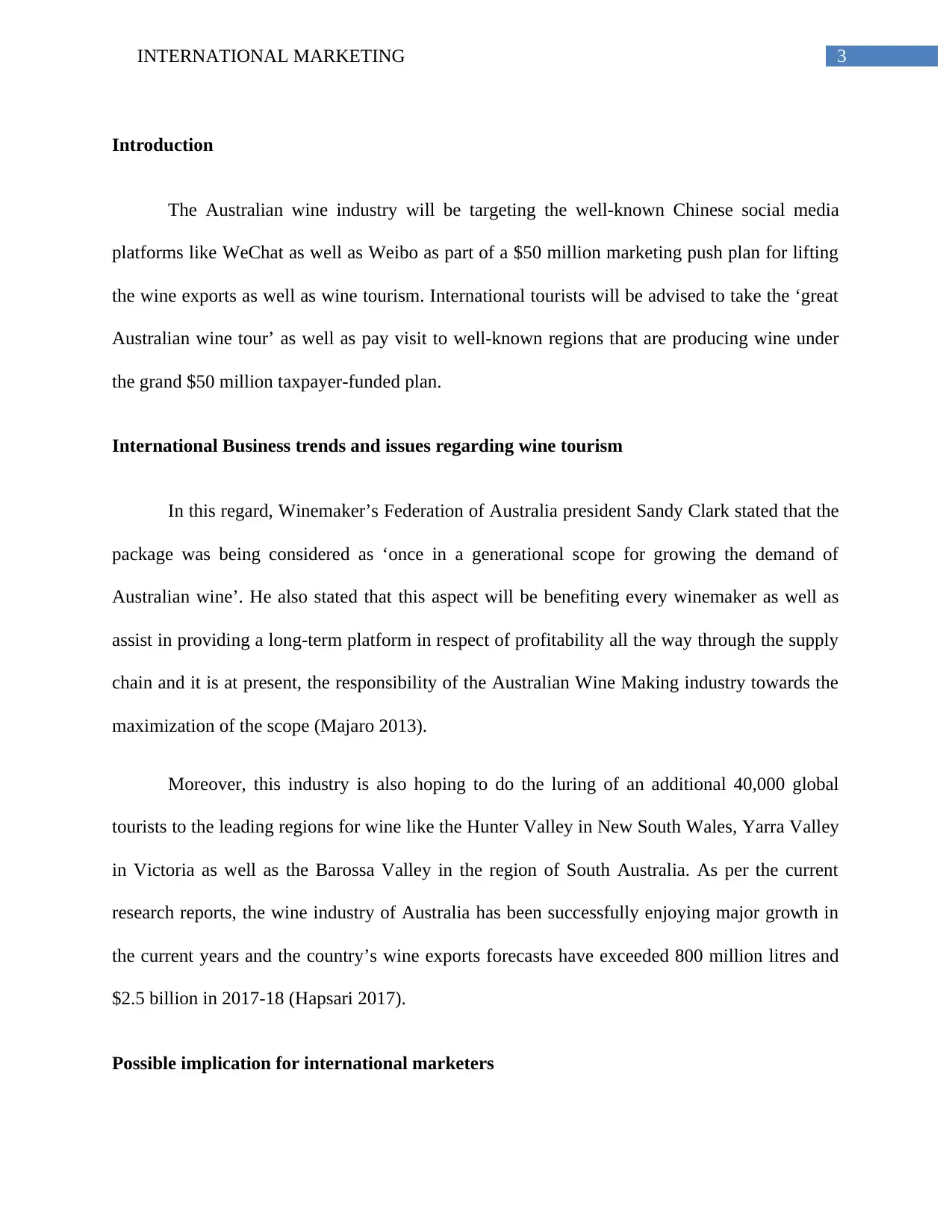
3INTERNATIONAL MARKETING
Introduction
The Australian wine industry will be targeting the well-known Chinese social media
platforms like WeChat as well as Weibo as part of a $50 million marketing push plan for lifting
the wine exports as well as wine tourism. International tourists will be advised to take the ‘great
Australian wine tour’ as well as pay visit to well-known regions that are producing wine under
the grand $50 million taxpayer-funded plan.
International Business trends and issues regarding wine tourism
In this regard, Winemaker’s Federation of Australia president Sandy Clark stated that the
package was being considered as ‘once in a generational scope for growing the demand of
Australian wine’. He also stated that this aspect will be benefiting every winemaker as well as
assist in providing a long-term platform in respect of profitability all the way through the supply
chain and it is at present, the responsibility of the Australian Wine Making industry towards the
maximization of the scope (Majaro 2013).
Moreover, this industry is also hoping to do the luring of an additional 40,000 global
tourists to the leading regions for wine like the Hunter Valley in New South Wales, Yarra Valley
in Victoria as well as the Barossa Valley in the region of South Australia. As per the current
research reports, the wine industry of Australia has been successfully enjoying major growth in
the current years and the country’s wine exports forecasts have exceeded 800 million litres and
$2.5 billion in 2017-18 (Hapsari 2017).
Possible implication for international marketers
Introduction
The Australian wine industry will be targeting the well-known Chinese social media
platforms like WeChat as well as Weibo as part of a $50 million marketing push plan for lifting
the wine exports as well as wine tourism. International tourists will be advised to take the ‘great
Australian wine tour’ as well as pay visit to well-known regions that are producing wine under
the grand $50 million taxpayer-funded plan.
International Business trends and issues regarding wine tourism
In this regard, Winemaker’s Federation of Australia president Sandy Clark stated that the
package was being considered as ‘once in a generational scope for growing the demand of
Australian wine’. He also stated that this aspect will be benefiting every winemaker as well as
assist in providing a long-term platform in respect of profitability all the way through the supply
chain and it is at present, the responsibility of the Australian Wine Making industry towards the
maximization of the scope (Majaro 2013).
Moreover, this industry is also hoping to do the luring of an additional 40,000 global
tourists to the leading regions for wine like the Hunter Valley in New South Wales, Yarra Valley
in Victoria as well as the Barossa Valley in the region of South Australia. As per the current
research reports, the wine industry of Australia has been successfully enjoying major growth in
the current years and the country’s wine exports forecasts have exceeded 800 million litres and
$2.5 billion in 2017-18 (Hapsari 2017).
Possible implication for international marketers
Paraphrase This Document
Need a fresh take? Get an instant paraphrase of this document with our AI Paraphraser
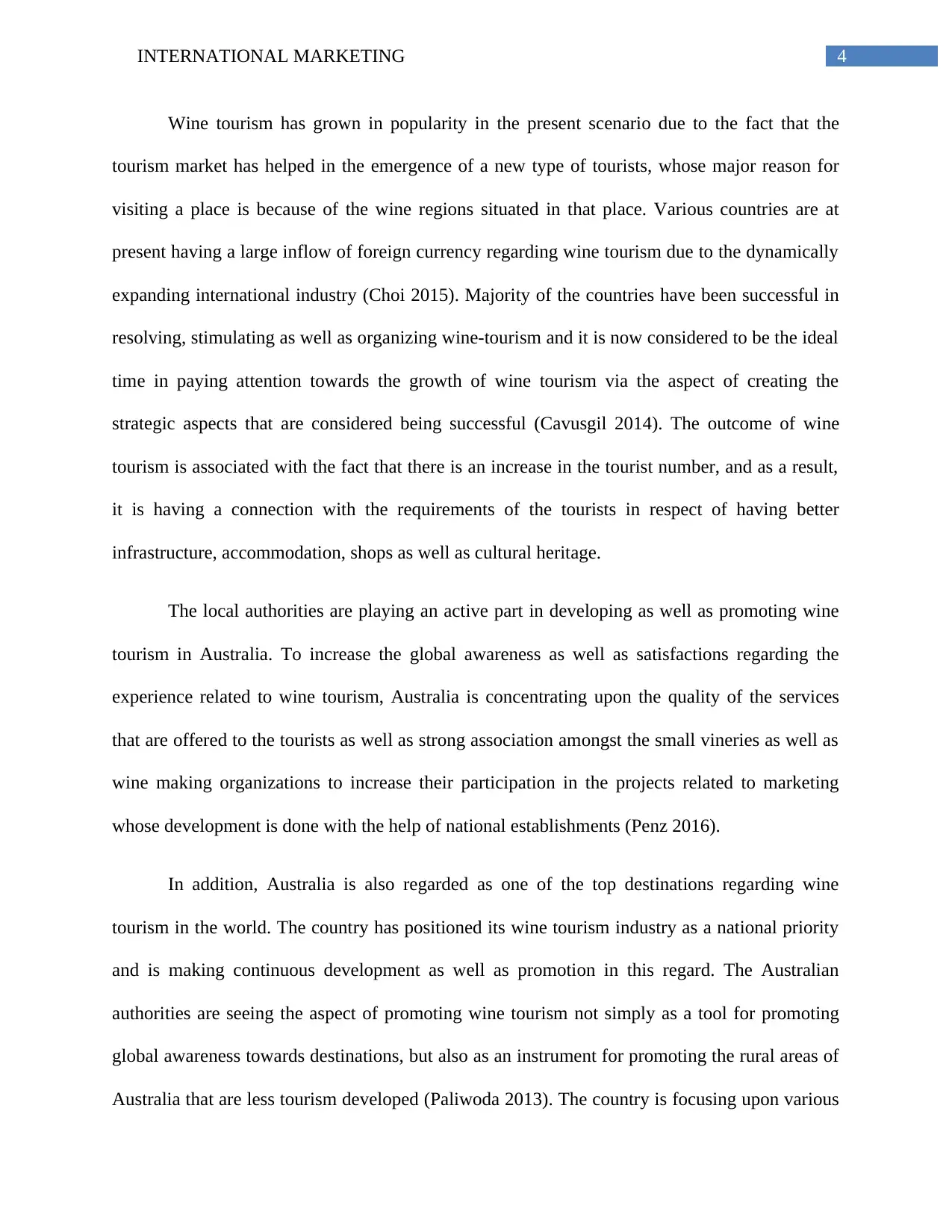
4INTERNATIONAL MARKETING
Wine tourism has grown in popularity in the present scenario due to the fact that the
tourism market has helped in the emergence of a new type of tourists, whose major reason for
visiting a place is because of the wine regions situated in that place. Various countries are at
present having a large inflow of foreign currency regarding wine tourism due to the dynamically
expanding international industry (Choi 2015). Majority of the countries have been successful in
resolving, stimulating as well as organizing wine-tourism and it is now considered to be the ideal
time in paying attention towards the growth of wine tourism via the aspect of creating the
strategic aspects that are considered being successful (Cavusgil 2014). The outcome of wine
tourism is associated with the fact that there is an increase in the tourist number, and as a result,
it is having a connection with the requirements of the tourists in respect of having better
infrastructure, accommodation, shops as well as cultural heritage.
The local authorities are playing an active part in developing as well as promoting wine
tourism in Australia. To increase the global awareness as well as satisfactions regarding the
experience related to wine tourism, Australia is concentrating upon the quality of the services
that are offered to the tourists as well as strong association amongst the small vineries as well as
wine making organizations to increase their participation in the projects related to marketing
whose development is done with the help of national establishments (Penz 2016).
In addition, Australia is also regarded as one of the top destinations regarding wine
tourism in the world. The country has positioned its wine tourism industry as a national priority
and is making continuous development as well as promotion in this regard. The Australian
authorities are seeing the aspect of promoting wine tourism not simply as a tool for promoting
global awareness towards destinations, but also as an instrument for promoting the rural areas of
Australia that are less tourism developed (Paliwoda 2013). The country is focusing upon various
Wine tourism has grown in popularity in the present scenario due to the fact that the
tourism market has helped in the emergence of a new type of tourists, whose major reason for
visiting a place is because of the wine regions situated in that place. Various countries are at
present having a large inflow of foreign currency regarding wine tourism due to the dynamically
expanding international industry (Choi 2015). Majority of the countries have been successful in
resolving, stimulating as well as organizing wine-tourism and it is now considered to be the ideal
time in paying attention towards the growth of wine tourism via the aspect of creating the
strategic aspects that are considered being successful (Cavusgil 2014). The outcome of wine
tourism is associated with the fact that there is an increase in the tourist number, and as a result,
it is having a connection with the requirements of the tourists in respect of having better
infrastructure, accommodation, shops as well as cultural heritage.
The local authorities are playing an active part in developing as well as promoting wine
tourism in Australia. To increase the global awareness as well as satisfactions regarding the
experience related to wine tourism, Australia is concentrating upon the quality of the services
that are offered to the tourists as well as strong association amongst the small vineries as well as
wine making organizations to increase their participation in the projects related to marketing
whose development is done with the help of national establishments (Penz 2016).
In addition, Australia is also regarded as one of the top destinations regarding wine
tourism in the world. The country has positioned its wine tourism industry as a national priority
and is making continuous development as well as promotion in this regard. The Australian
authorities are seeing the aspect of promoting wine tourism not simply as a tool for promoting
global awareness towards destinations, but also as an instrument for promoting the rural areas of
Australia that are less tourism developed (Paliwoda 2013). The country is focusing upon various
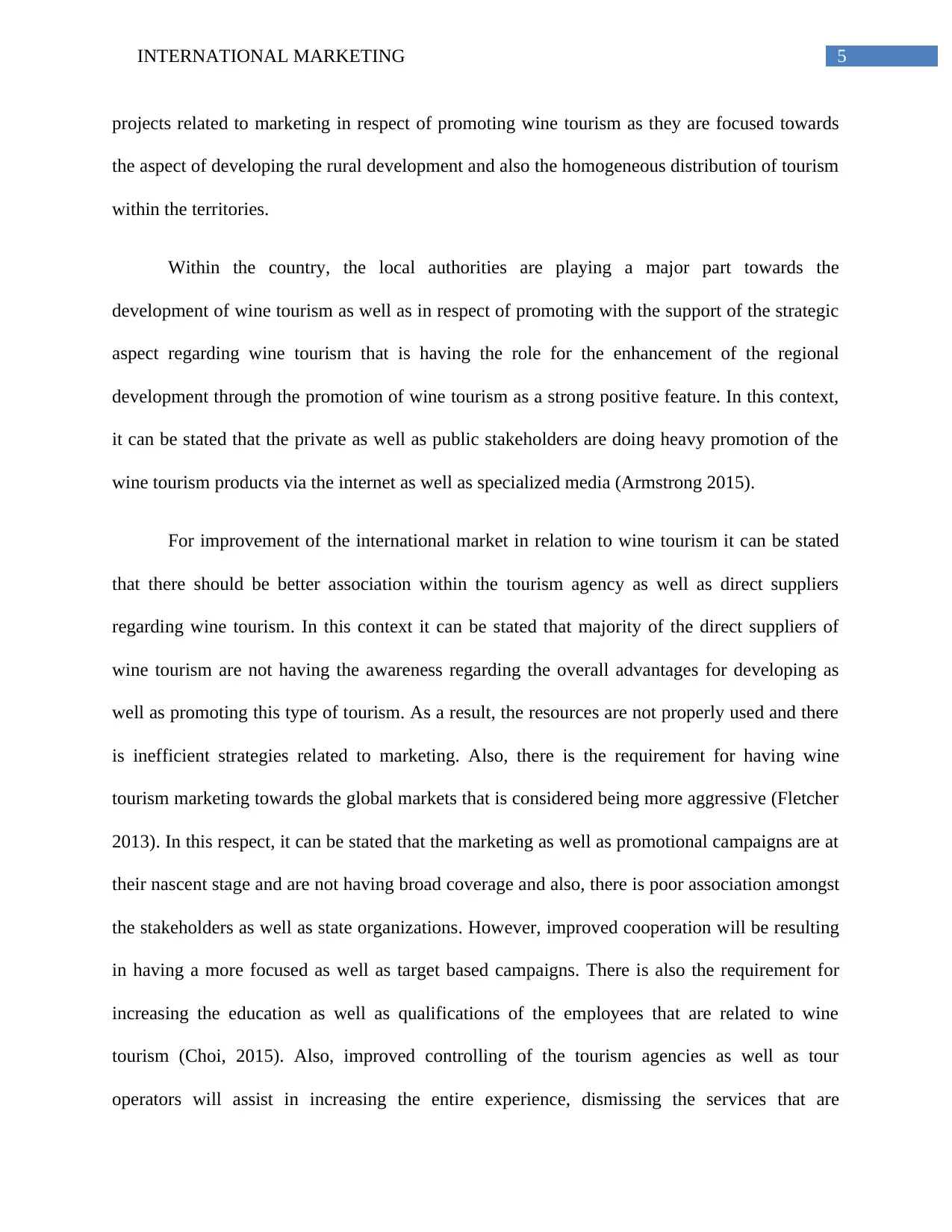
5INTERNATIONAL MARKETING
projects related to marketing in respect of promoting wine tourism as they are focused towards
the aspect of developing the rural development and also the homogeneous distribution of tourism
within the territories.
Within the country, the local authorities are playing a major part towards the
development of wine tourism as well as in respect of promoting with the support of the strategic
aspect regarding wine tourism that is having the role for the enhancement of the regional
development through the promotion of wine tourism as a strong positive feature. In this context,
it can be stated that the private as well as public stakeholders are doing heavy promotion of the
wine tourism products via the internet as well as specialized media (Armstrong 2015).
For improvement of the international market in relation to wine tourism it can be stated
that there should be better association within the tourism agency as well as direct suppliers
regarding wine tourism. In this context it can be stated that majority of the direct suppliers of
wine tourism are not having the awareness regarding the overall advantages for developing as
well as promoting this type of tourism. As a result, the resources are not properly used and there
is inefficient strategies related to marketing. Also, there is the requirement for having wine
tourism marketing towards the global markets that is considered being more aggressive (Fletcher
2013). In this respect, it can be stated that the marketing as well as promotional campaigns are at
their nascent stage and are not having broad coverage and also, there is poor association amongst
the stakeholders as well as state organizations. However, improved cooperation will be resulting
in having a more focused as well as target based campaigns. There is also the requirement for
increasing the education as well as qualifications of the employees that are related to wine
tourism (Choi, 2015). Also, improved controlling of the tourism agencies as well as tour
operators will assist in increasing the entire experience, dismissing the services that are
projects related to marketing in respect of promoting wine tourism as they are focused towards
the aspect of developing the rural development and also the homogeneous distribution of tourism
within the territories.
Within the country, the local authorities are playing a major part towards the
development of wine tourism as well as in respect of promoting with the support of the strategic
aspect regarding wine tourism that is having the role for the enhancement of the regional
development through the promotion of wine tourism as a strong positive feature. In this context,
it can be stated that the private as well as public stakeholders are doing heavy promotion of the
wine tourism products via the internet as well as specialized media (Armstrong 2015).
For improvement of the international market in relation to wine tourism it can be stated
that there should be better association within the tourism agency as well as direct suppliers
regarding wine tourism. In this context it can be stated that majority of the direct suppliers of
wine tourism are not having the awareness regarding the overall advantages for developing as
well as promoting this type of tourism. As a result, the resources are not properly used and there
is inefficient strategies related to marketing. Also, there is the requirement for having wine
tourism marketing towards the global markets that is considered being more aggressive (Fletcher
2013). In this respect, it can be stated that the marketing as well as promotional campaigns are at
their nascent stage and are not having broad coverage and also, there is poor association amongst
the stakeholders as well as state organizations. However, improved cooperation will be resulting
in having a more focused as well as target based campaigns. There is also the requirement for
increasing the education as well as qualifications of the employees that are related to wine
tourism (Choi, 2015). Also, improved controlling of the tourism agencies as well as tour
operators will assist in increasing the entire experience, dismissing the services that are
⊘ This is a preview!⊘
Do you want full access?
Subscribe today to unlock all pages.

Trusted by 1+ million students worldwide
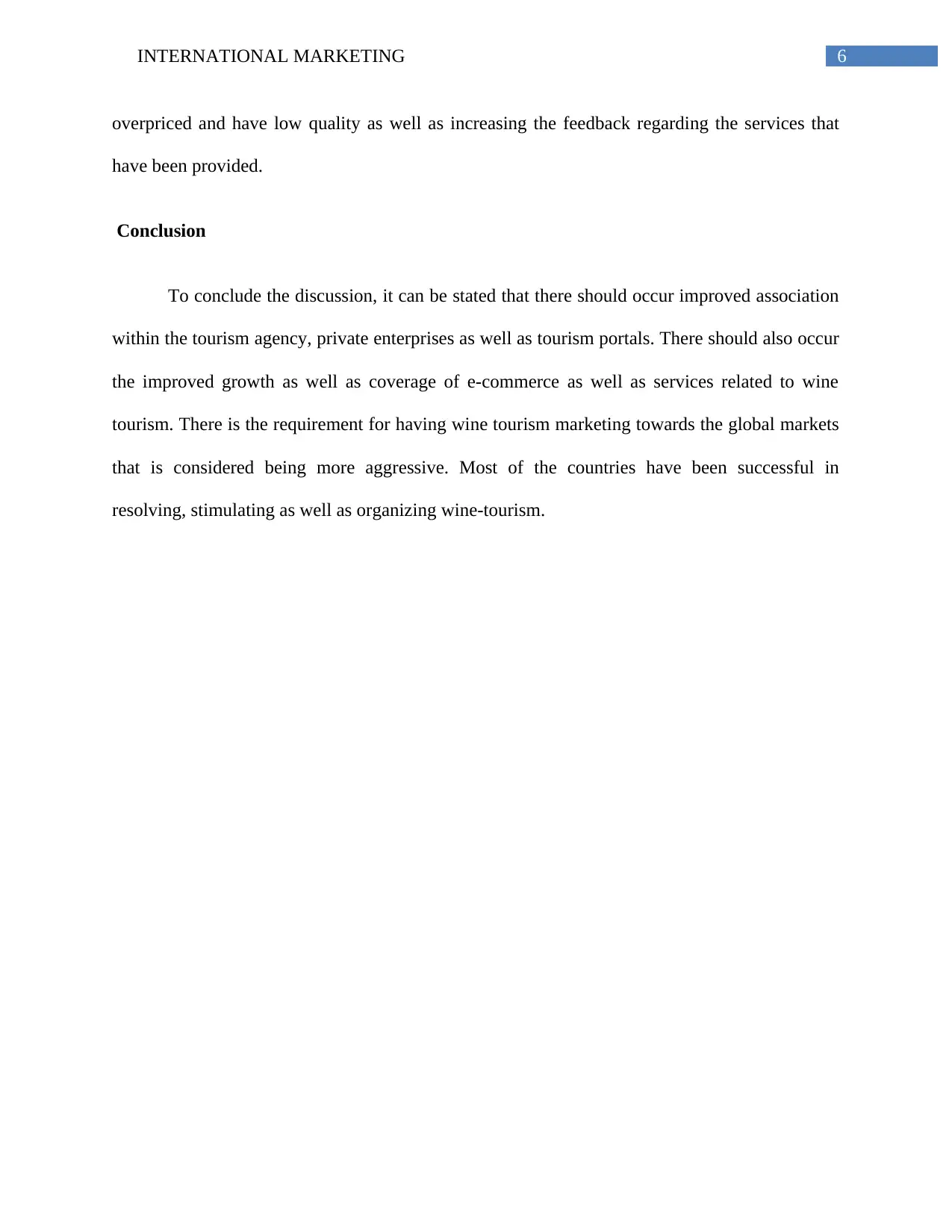
6INTERNATIONAL MARKETING
overpriced and have low quality as well as increasing the feedback regarding the services that
have been provided.
Conclusion
To conclude the discussion, it can be stated that there should occur improved association
within the tourism agency, private enterprises as well as tourism portals. There should also occur
the improved growth as well as coverage of e-commerce as well as services related to wine
tourism. There is the requirement for having wine tourism marketing towards the global markets
that is considered being more aggressive. Most of the countries have been successful in
resolving, stimulating as well as organizing wine-tourism.
overpriced and have low quality as well as increasing the feedback regarding the services that
have been provided.
Conclusion
To conclude the discussion, it can be stated that there should occur improved association
within the tourism agency, private enterprises as well as tourism portals. There should also occur
the improved growth as well as coverage of e-commerce as well as services related to wine
tourism. There is the requirement for having wine tourism marketing towards the global markets
that is considered being more aggressive. Most of the countries have been successful in
resolving, stimulating as well as organizing wine-tourism.
Paraphrase This Document
Need a fresh take? Get an instant paraphrase of this document with our AI Paraphraser
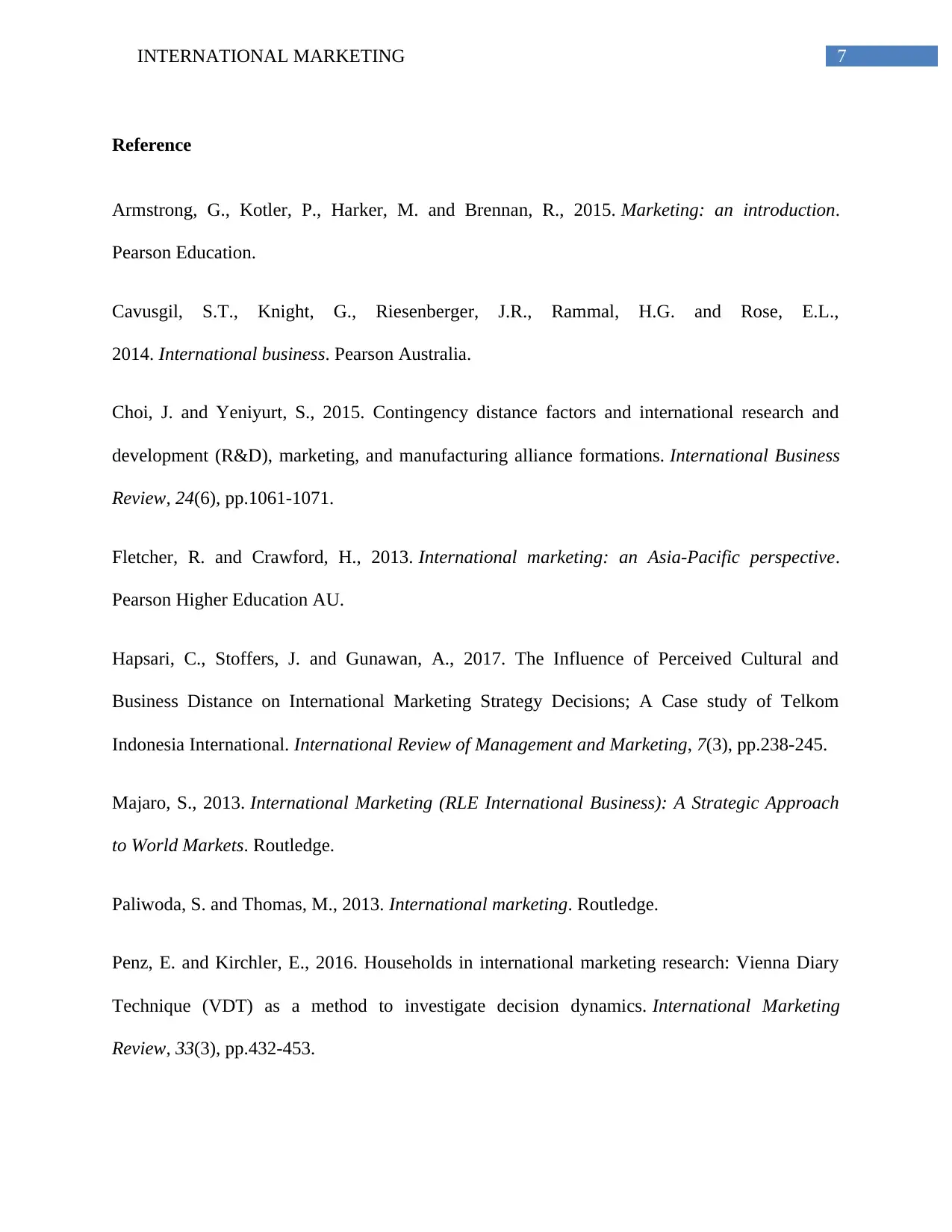
7INTERNATIONAL MARKETING
Reference
Armstrong, G., Kotler, P., Harker, M. and Brennan, R., 2015. Marketing: an introduction.
Pearson Education.
Cavusgil, S.T., Knight, G., Riesenberger, J.R., Rammal, H.G. and Rose, E.L.,
2014. International business. Pearson Australia.
Choi, J. and Yeniyurt, S., 2015. Contingency distance factors and international research and
development (R&D), marketing, and manufacturing alliance formations. International Business
Review, 24(6), pp.1061-1071.
Fletcher, R. and Crawford, H., 2013. International marketing: an Asia-Pacific perspective.
Pearson Higher Education AU.
Hapsari, C., Stoffers, J. and Gunawan, A., 2017. The Influence of Perceived Cultural and
Business Distance on International Marketing Strategy Decisions; A Case study of Telkom
Indonesia International. International Review of Management and Marketing, 7(3), pp.238-245.
Majaro, S., 2013. International Marketing (RLE International Business): A Strategic Approach
to World Markets. Routledge.
Paliwoda, S. and Thomas, M., 2013. International marketing. Routledge.
Penz, E. and Kirchler, E., 2016. Households in international marketing research: Vienna Diary
Technique (VDT) as a method to investigate decision dynamics. International Marketing
Review, 33(3), pp.432-453.
Reference
Armstrong, G., Kotler, P., Harker, M. and Brennan, R., 2015. Marketing: an introduction.
Pearson Education.
Cavusgil, S.T., Knight, G., Riesenberger, J.R., Rammal, H.G. and Rose, E.L.,
2014. International business. Pearson Australia.
Choi, J. and Yeniyurt, S., 2015. Contingency distance factors and international research and
development (R&D), marketing, and manufacturing alliance formations. International Business
Review, 24(6), pp.1061-1071.
Fletcher, R. and Crawford, H., 2013. International marketing: an Asia-Pacific perspective.
Pearson Higher Education AU.
Hapsari, C., Stoffers, J. and Gunawan, A., 2017. The Influence of Perceived Cultural and
Business Distance on International Marketing Strategy Decisions; A Case study of Telkom
Indonesia International. International Review of Management and Marketing, 7(3), pp.238-245.
Majaro, S., 2013. International Marketing (RLE International Business): A Strategic Approach
to World Markets. Routledge.
Paliwoda, S. and Thomas, M., 2013. International marketing. Routledge.
Penz, E. and Kirchler, E., 2016. Households in international marketing research: Vienna Diary
Technique (VDT) as a method to investigate decision dynamics. International Marketing
Review, 33(3), pp.432-453.
1 out of 8
Related Documents
Your All-in-One AI-Powered Toolkit for Academic Success.
+13062052269
info@desklib.com
Available 24*7 on WhatsApp / Email
![[object Object]](/_next/static/media/star-bottom.7253800d.svg)
Unlock your academic potential
Copyright © 2020–2025 A2Z Services. All Rights Reserved. Developed and managed by ZUCOL.





